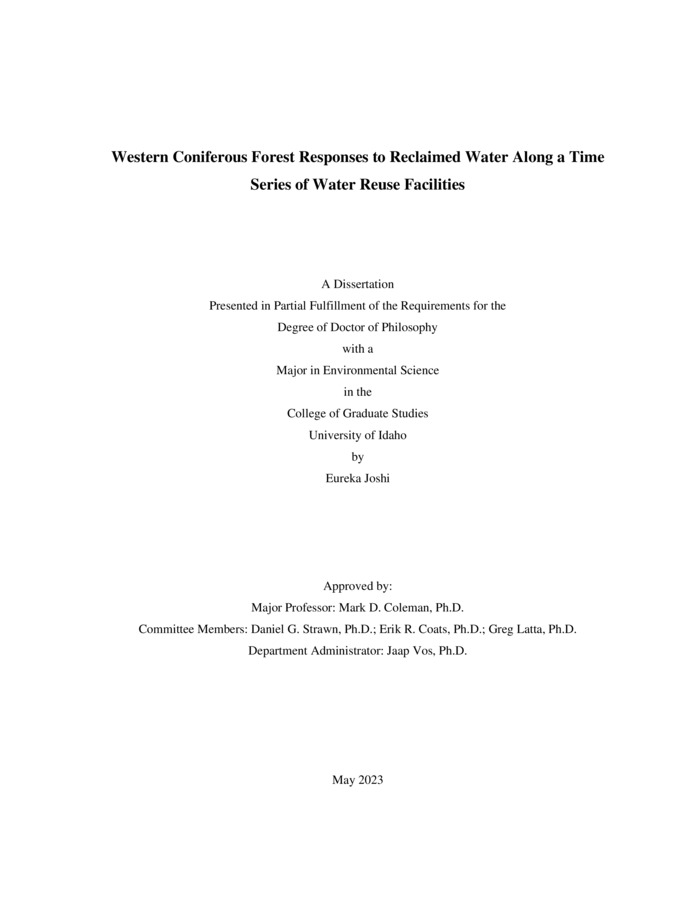Western Coniferous Forest Responses to Reclaimed Water Along a Time Series of Water Reuse Facilities
Joshi, Eureka. (2023-05). Western Coniferous Forest Responses to Reclaimed Water Along a Time Series of Water Reuse Facilities. Theses and Dissertations Collection, University of Idaho Library Digital Collections. https://www.lib.uidaho.edu/digital/etd/items/joshi_idaho_0089e_12632.html
- Title:
- Western Coniferous Forest Responses to Reclaimed Water Along a Time Series of Water Reuse Facilities
- Author:
- Joshi, Eureka
- Date:
- 2023-05
- Program:
- Environmental Science
- Subject Category:
- Environmental science
- Abstract:
-
Forest water reclamation is a cost-effective method of managing treated municipal wastewater or reclaimed water by disposal on native forests. It provides a unique opportunity to combine forest productivity with improved water quality. However, prolonged application may have detrimental effects on forest health and water quality. This dissertation uses three studies to investigate the long-term effects of reclaimed water land application on forest responses along a four-decade time series of water reuse facilities in northern Idaho. First, tree growth and vegetation diversity responses were investigated using tree rings and vegetation diversity indices. Forest water reclamation substantially improved tree growth responses by 30% to more than 100%. However, a decline in tree growth and understory vegetation diversity occurred with increasing length of treatment, particularly after three decades of treatment. Second, this dissertation investigated soil water nitrogen (N) and phosphorus (P) concentrations and potential leaching rates using drain gauges and porous cup tension lysimeters to capture preferential flow and soil matrix flow. Soil water samples were analyzed using a suite of microplate-based colorimetric assays. The leaching rates were calculated as a product of drainage and nutrient concentrations. Concerning levels of nitrate (NO3-) leaching occurred at the long-established facilities, where forests had received more than 30 years of reclaimed water. While phosphate (PO43-) leaching losses were minimal, both NO3- and PO43- leached predominantly through preferential flow paths. Finally, soil CO2 efflux, exoenzyme activities and amino compounds were quantified to study soil biological responses of forests to long-term reclaimed water application. Amending forest with reclaimed water had little effect on soil biological responses except for N-releasing chitinase activity and P-releasing acid phosphatase activities. Soil chitinase activities were suppressed by effluent treatment especially at long-established facilities due to a possible shift in microbial composition. The suppression in litter phosphatase activities indicates an abundance in readily available P supplied in reclaimed water. In addition, higher amino acid uptake for the reclaimed water treated plots at the recently established facilities may indicate N-limitation and reliance on a broader range of organic and inorganic sources for N acquisition from the ecosystem.
- Description:
- doctoral, Ph.D., Environmental Science -- University of Idaho - College of Graduate Studies, 2023-05
- Major Professor:
- Coleman, Mark D
- Committee:
- Strawn, Daniel G.; Coats, Erik R; Latta, Greg; Vos, Jaap
- Defense Date:
- 2023-05
- Identifier:
- Joshi_idaho_0089E_12632
- Type:
- Text
- Format Original:
- Format:
- application/pdf
- Rights:
- In Copyright - Educational Use Permitted. For more information, please contact University of Idaho Library Special Collections and Archives Department at libspec@uidaho.edu.
- Standardized Rights:
- http://rightsstatements.org/vocab/InC-EDU/1.0/

